sensor FIAT 500L 2019 Owner handbook (in English)
[x] Cancel search | Manufacturer: FIAT, Model Year: 2019, Model line: 500L, Model: FIAT 500L 2019Pages: 248, PDF Size: 5.74 MB
Page 76 of 248
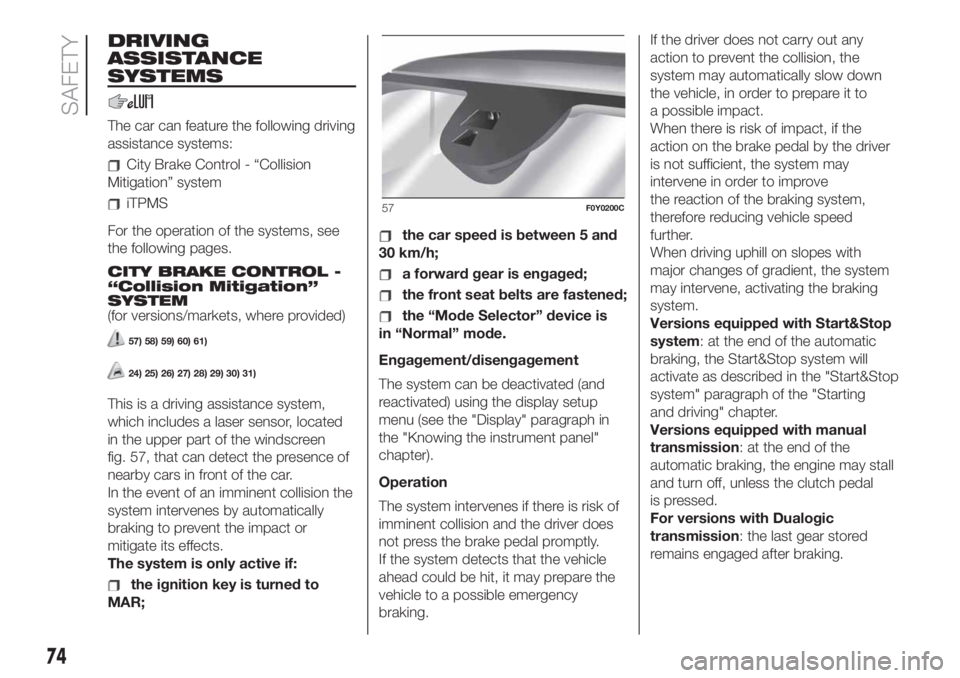
DRIVING
ASSISTANCE
SYSTEMS
The car can feature the following driving
assistance systems:
City Brake Control - “Collision
Mitigation” system
iTPMS
For the operation of the systems, see
the following pages.
CITY BRAKE CONTROL -
“Collision Mitigation”
SYSTEM
(for versions/markets, where provided)
57) 58) 59) 60) 61)
24) 25) 26) 27) 28) 29) 30) 31)
This is a driving assistance system,
which includes a laser sensor, located
in the upper part of the windscreen
fig. 57, that can detect the presence of
nearby cars in front of the car.
In the event of an imminent collision the
system intervenes by automatically
braking to prevent the impact or
mitigate its effects.
The system is only active if:
the ignition key is turned to
MAR;
the car speed is between 5 and
30 km/h;
a forward gear is engaged;
the front seat belts are fastened;
the “Mode Selector” device is
in “Normal” mode.
Engagement/disengagement
The system can be deactivated (and
reactivated) using the display setup
menu (see the "Display" paragraph in
the "Knowing the instrument panel"
chapter).
Operation
The system intervenes if there is risk of
imminent collision and the driver does
not press the brake pedal promptly.
If the system detects that the vehicle
ahead could be hit, it may prepare the
vehicle to a possible emergency
braking.If the driver does not carry out any
action to prevent the collision, the
system may automatically slow down
the vehicle, in order to prepare it to
a possible impact.
When there is risk of impact, if the
action on the brake pedal by the driver
is not sufficient, the system may
intervene in order to improve
the reaction of the braking system,
therefore reducing vehicle speed
further.
When driving uphill on slopes with
major changes of gradient, the system
may intervene, activating the braking
system.
Versions equipped with Start&Stop
system: at the end of the automatic
braking, the Start&Stop system will
activate as described in the "Start&Stop
system" paragraph of the "Starting
and driving" chapter.
Versions equipped with manual
transmission: at the end of the
automatic braking, the engine may stall
and turn off, unless the clutch pedal
is pressed.
For versions with Dualogic
transmission: the last gear stored
remains engaged after braking.
57F0Y0200C
74
SAFETY
Page 77 of 248
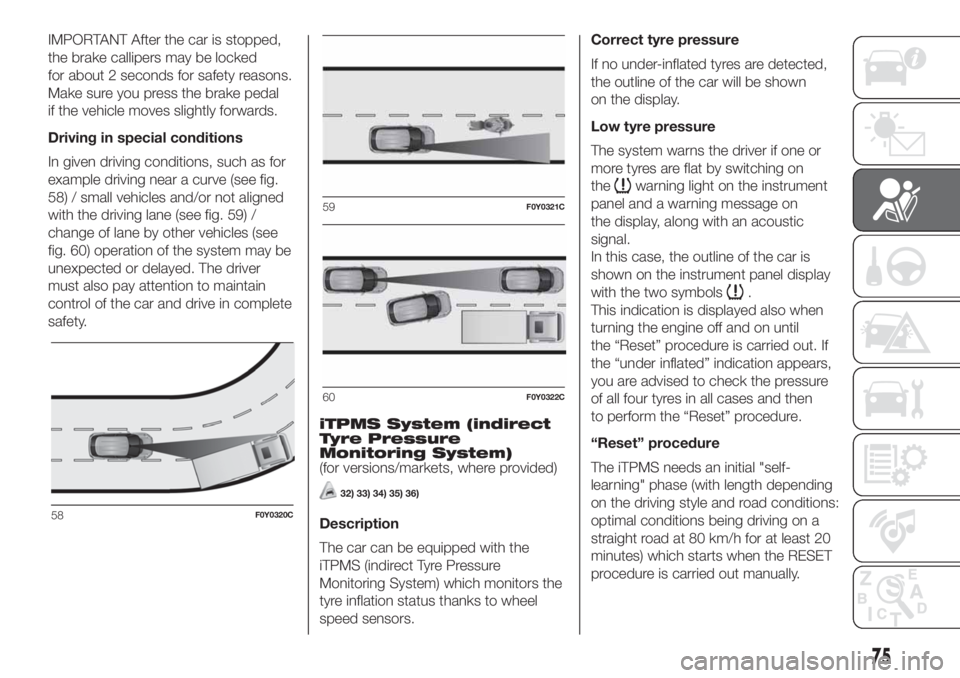
IMPORTANT After the car is stopped,
the brake callipers may be locked
for about 2 seconds for safety reasons.
Make sure you press the brake pedal
if the vehicle moves slightly forwards.
Driving in special conditions
In given driving conditions, such as for
example driving near a curve (see fig.
58) / small vehicles and/or not aligned
with the driving lane (see fig. 59) /
change of lane by other vehicles (see
fig. 60) operation of the system may be
unexpected or delayed. The driver
must also pay attention to maintain
control of the car and drive in complete
safety.
iTPMS System (indirect
Tyre Pressure
Monitoring System)
(for versions/markets, where provided)
32) 33) 34) 35) 36)
Description
The car can be equipped with the
iTPMS (indirect Tyre Pressure
Monitoring System) which monitors the
tyre inflation status thanks to wheel
speed sensors.Correct tyre pressure
If no under-inflated tyres are detected,
the outline of the car will be shown
on the display.
Low tyre pressure
The system warns the driver if one or
more tyres are flat by switching on
the
warning light on the instrument
panel and a warning message on
the display, along with an acoustic
signal.
In this case, the outline of the car is
shown on the instrument panel display
with the two symbols
.
This indication is displayed also when
turning the engine off and on until
the “Reset” procedure is carried out. If
the “under inflated” indication appears,
you are advised to check the pressure
of all four tyres in all cases and then
to perform the “Reset” procedure.
“Reset” procedure
The iTPMS needs an initial "self-
learning" phase (with length depending
on the driving style and road conditions:
optimal conditions being driving on a
straight road at 80 km/h for at least 20
minutes) which starts when the RESET
procedure is carried out manually.
58F0Y0320C
59F0Y0321C
60F0Y0322C
75
Page 79 of 248
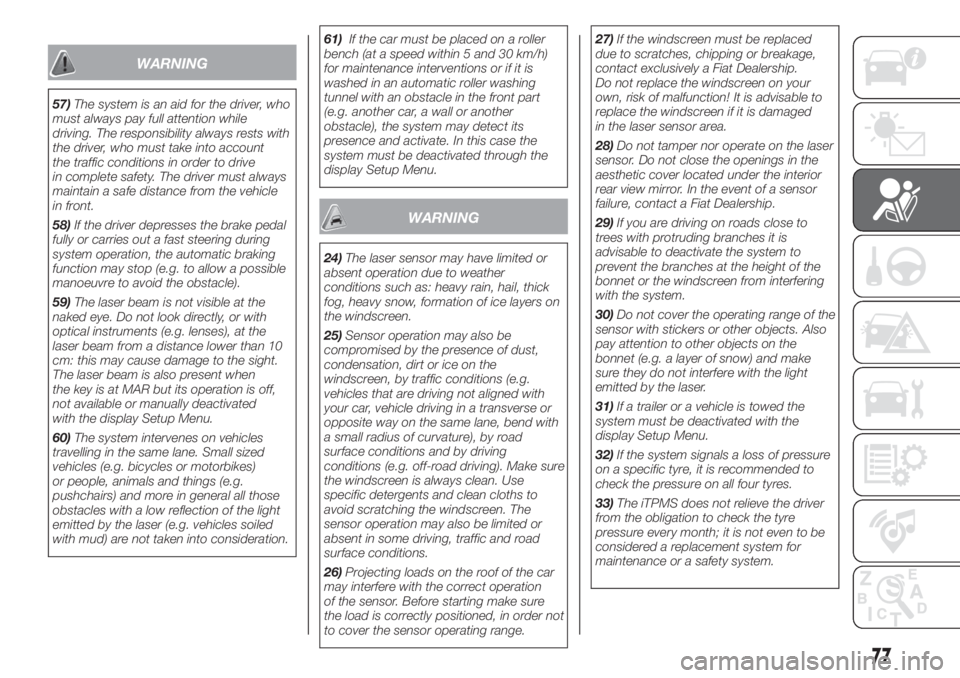
WARNING
57)The system is an aid for the driver, who
must always pay full attention while
driving. The responsibility always rests with
the driver, who must take into account
the traffic conditions in order to drive
in complete safety. The driver must always
maintain a safe distance from the vehicle
in front.
58)If the driver depresses the brake pedal
fully or carries out a fast steering during
system operation, the automatic braking
function may stop (e.g. to allow a possible
manoeuvre to avoid the obstacle).
59)The laser beam is not visible at the
naked eye. Do not look directly, or with
optical instruments (e.g. lenses), at the
laser beam from a distance lower than 10
cm: this may cause damage to the sight.
The laser beam is also present when
the key is at MAR but its operation is off,
not available or manually deactivated
with the display Setup Menu.
60)The system intervenes on vehicles
travelling in the same lane. Small sized
vehicles (e.g. bicycles or motorbikes)
or people, animals and things (e.g.
pushchairs) and more in general all those
obstacles with a low reflection of the light
emitted by the laser (e.g. vehicles soiled
with mud) are not taken into consideration.61)If the car must be placed on a roller
bench (at a speed within 5 and 30 km/h)
for maintenance interventions or if it is
washed in an automatic roller washing
tunnel with an obstacle in the front part
(e.g. another car, a wall or another
obstacle), the system may detect its
presence and activate. In this case the
system must be deactivated through the
display Setup Menu.
WARNING
24)The laser sensor may have limited or
absent operation due to weather
conditions such as: heavy rain, hail, thick
fog, heavy snow, formation of ice layers on
the windscreen.
25)Sensor operation may also be
compromised by the presence of dust,
condensation, dirt or ice on the
windscreen, by traffic conditions (e.g.
vehicles that are driving not aligned with
your car, vehicle driving in a transverse or
opposite way on the same lane, bend with
a small radius of curvature), by road
surface conditions and by driving
conditions (e.g. off-road driving). Make sure
the windscreen is always clean. Use
specific detergents and clean cloths to
avoid scratching the windscreen. The
sensor operation may also be limited or
absent in some driving, traffic and road
surface conditions.
26)Projecting loads on the roof of the car
may interfere with the correct operation
of the sensor. Before starting make sure
the load is correctly positioned, in order not
to cover the sensor operating range.27)If the windscreen must be replaced
due to scratches, chipping or breakage,
contact exclusively a Fiat Dealership.
Do not replace the windscreen on your
own, risk of malfunction! It is advisable to
replace the windscreen if it is damaged
in the laser sensor area.
28)Do not tamper nor operate on the laser
sensor. Do not close the openings in the
aesthetic cover located under the interior
rear view mirror. In the event of a sensor
failure, contact a Fiat Dealership.
29)If you are driving on roads close to
trees with protruding branches it is
advisable to deactivate the system to
prevent the branches at the height of the
bonnet or the windscreen from interfering
with the system.
30)Do not cover the operating range of the
sensor with stickers or other objects. Also
pay attention to other objects on the
bonnet (e.g. a layer of snow) and make
sure they do not interfere with the light
emitted by the laser.
31)If a trailer or a vehicle is towed the
system must be deactivated with the
display Setup Menu.
32)If the system signals a loss of pressure
on a specific tyre, it is recommended to
check the pressure on all four tyres.
33)The iTPMS does not relieve the driver
from the obligation to check the tyre
pressure every month; it is not even to be
considered a replacement system for
maintenance or a safety system.
77
Page 104 of 248

STARTING AND DRIVING
Let’s get to the core of the vehicle:
seeing how you can exploit all of its
potential to the full.
We’ll look at how to drive it safely in any
situation, so that it can be a welcome
companion, with our comfort and
our wallets in mind.STARTING THE ENGINE .................103
WHEN PARKED ..............................104
HANDBRAKE ..................................104
USING THE MANUAL
TRANSMISSION .............................105
USING THE DUALOGIC
GEARBOX.......................................106
START&STOP SYSTEM ..................108
CRUISE CONTROL (CONSTANT
SPEED REGULATOR) .....................109
SPEED LIMITER ..............................110
MODE SELECTOR ..........................111
PARKING SENSORS.......................114
REAR BACKUP CAMERA
(PARKVIEW® REAR BACKUP
CAMERA) ........................................116
TOWING TRAILERS ........................117
REFUELLING THE VEHICLE ...........118
ADBLUE® (UREA) ADDITIVE FOR
DIESEL EMISSIONS ........................121
102
STARTING AND DRIVING
Page 116 of 248
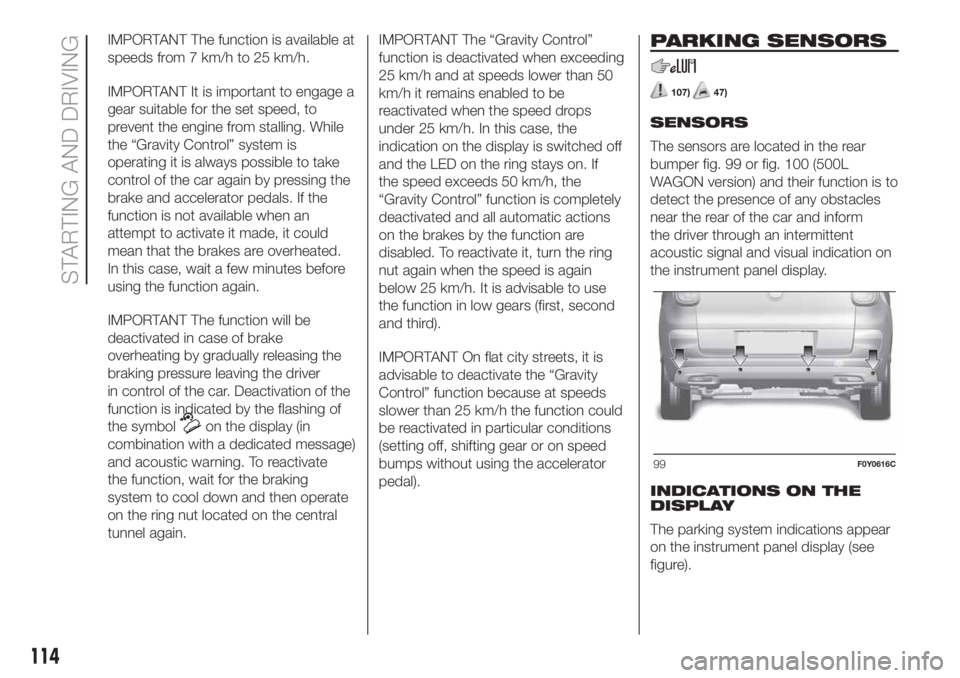
IMPORTANT The function is available at
speeds from 7 km/h to 25 km/h.
IMPORTANT It is important to engage a
gear suitable for the set speed, to
prevent the engine from stalling. While
the “Gravity Control” system is
operating it is always possible to take
control of the car again by pressing the
brake and accelerator pedals. If the
function is not available when an
attempt to activate it made, it could
mean that the brakes are overheated.
In this case, wait a few minutes before
using the function again.
IMPORTANT The function will be
deactivated in case of brake
overheating by gradually releasing the
braking pressure leaving the driver
in control of the car. Deactivation of the
function is indicated by the flashing of
the symbol
on the display (in
combination with a dedicated message)
and acoustic warning. To reactivate
the function, wait for the braking
system to cool down and then operate
on the ring nut located on the central
tunnel again.IMPORTANT The “Gravity Control”
function is deactivated when exceeding
25 km/h and at speeds lower than 50
km/h it remains enabled to be
reactivated when the speed drops
under 25 km/h. In this case, the
indication on the display is switched off
and the LED on the ring stays on. If
the speed exceeds 50 km/h, the
“Gravity Control” function is completely
deactivated and all automatic actions
on the brakes by the function are
disabled. To reactivate it, turn the ring
nut again when the speed is again
below 25 km/h. It is advisable to use
the function in low gears (first, second
and third).
IMPORTANT On flat city streets, it is
advisable to deactivate the “Gravity
Control” function because at speeds
slower than 25 km/h the function could
be reactivated in particular conditions
(setting off, shifting gear or on speed
bumps without using the accelerator
pedal).
PARKING SENSORS
107)47)
SENSORS
The sensors are located in the rear
bumper fig. 99 or fig. 100 (500L
WAGON version) and their function is to
detect the presence of any obstacles
near the rear of the car and inform
the driver through an intermittent
acoustic signal and visual indication on
the instrument panel display.
INDICATIONS ON THE
DISPLAY
The parking system indications appear
on the instrument panel display (see
figure).
99F0Y0616C
114
STARTING AND DRIVING
Page 117 of 248
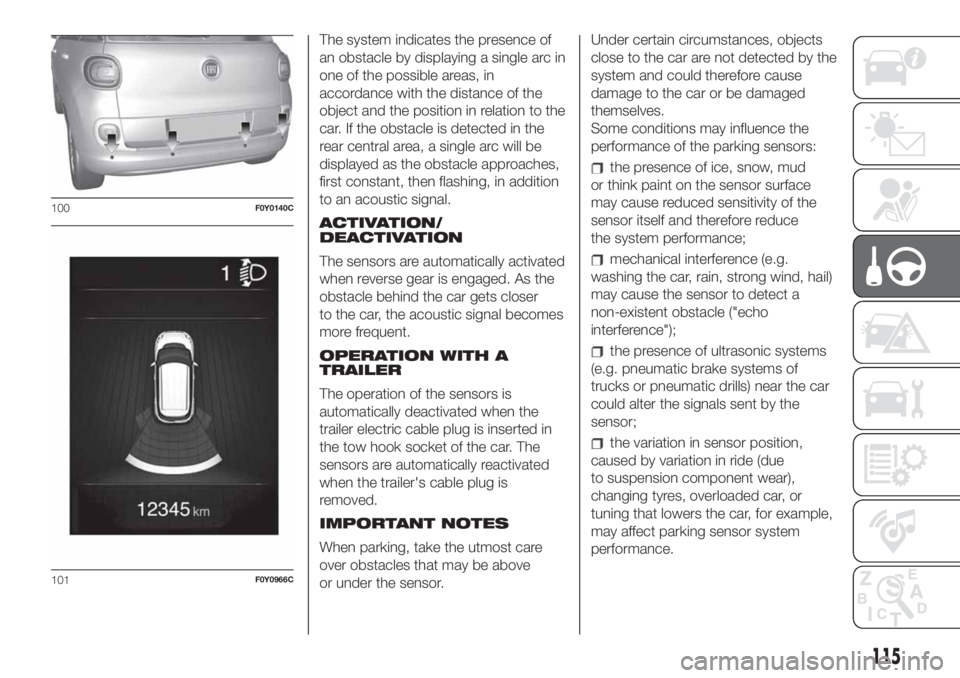
The system indicates the presence of
an obstacle by displaying a single arc in
one of the possible areas, in
accordance with the distance of the
object and the position in relation to the
car. If the obstacle is detected in the
rear central area, a single arc will be
displayed as the obstacle approaches,
first constant, then flashing, in addition
to an acoustic signal.
ACTIVATION/
DEACTIVATION
The sensors are automatically activated
when reverse gear is engaged. As the
obstacle behind the car gets closer
to the car, the acoustic signal becomes
more frequent.
OPERATION WITH A
TRAILER
The operation of the sensors is
automatically deactivated when the
trailer electric cable plug is inserted in
the tow hook socket of the car. The
sensors are automatically reactivated
when the trailer's cable plug is
removed.
IMPORTANT NOTES
When parking, take the utmost care
over obstacles that may be above
or under the sensor.Under certain circumstances, objects
close to the car are not detected by the
system and could therefore cause
damage to the car or be damaged
themselves.
Some conditions may influence the
performance of the parking sensors:
the presence of ice, snow, mud
or think paint on the sensor surface
may cause reduced sensitivity of the
sensor itself and therefore reduce
the system performance;
mechanical interference (e.g.
washing the car, rain, strong wind, hail)
may cause the sensor to detect a
non-existent obstacle ("echo
interference");
the presence of ultrasonic systems
(e.g. pneumatic brake systems of
trucks or pneumatic drills) near the car
could alter the signals sent by the
sensor;
the variation in sensor position,
caused by variation in ride (due
to suspension component wear),
changing tyres, overloaded car, or
tuning that lowers the car, for example,
may affect parking sensor system
performance.
100F0Y0140C
101F0Y0966C
115
Page 118 of 248
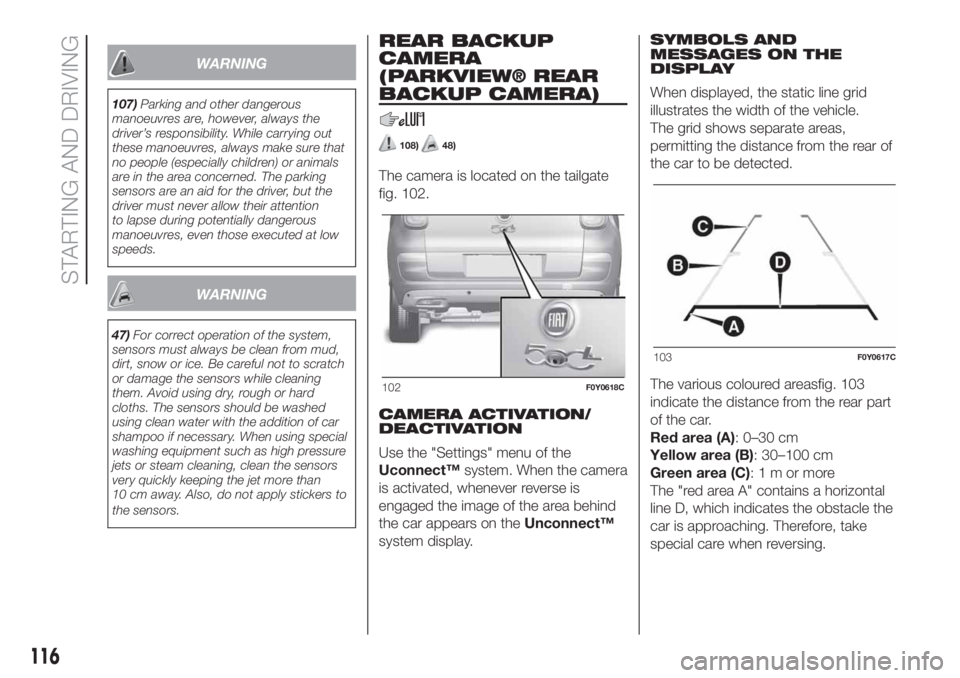
WARNING
107)Parking and other dangerous
manoeuvres are, however, always the
driver’s responsibility. While carrying out
these manoeuvres, always make sure that
no people (especially children) or animals
are in the area concerned. The parking
sensors are an aid for the driver, but the
driver must never allow their attention
to lapse during potentially dangerous
manoeuvres, even those executed at low
speeds.
WARNING
47)For correct operation of the system,
sensors must always be clean from mud,
dirt, snow or ice. Be careful not to scratch
or damage the sensors while cleaning
them. Avoid using dry, rough or hard
cloths. The sensors should be washed
using clean water with the addition of car
shampoo if necessary. When using special
washing equipment such as high pressure
jets or steam cleaning, clean the sensors
very quickly keeping the jet more than
10 cm away. Also, do not apply stickers to
the sensors.
REAR BACKUP
CAMERA
(PARKVIEW® REAR
BACKUP CAMERA)
108)48)
The camera is located on the tailgate
fig. 102.
CAMERA ACTIVATION/
DEACTIVATION
Use the "Settings" menu of the
Uconnect™system. When the camera
is activated, whenever reverse is
engaged the image of the area behind
the car appears on theUnconnect™
system display.SYMBOLS AND
MESSAGES ON THE
DISPLAY
When displayed, the static line grid
illustrates the width of the vehicle.
The grid shows separate areas,
permitting the distance from the rear of
the car to be detected.
The various coloured areasfig. 103
indicate the distance from the rear part
of the car.
Red area (A): 0–30 cm
Yellow area (B): 30–100 cm
Green area (C):1mormore
The "red area A" contains a horizontal
line D, which indicates the obstacle the
car is approaching. Therefore, take
special care when reversing.
102F0Y0618C
103F0Y0617C
116
STARTING AND DRIVING
Page 119 of 248

IMPORTANT When parking, take the
utmost care over obstacles that may be
above or under the operating range of
the camera.
WARNING
108)Parking and other potentially
dangerous manoeuvres are, however,
always the driver’s responsibility. While
carrying out these manoeuvres, always
make sure that no people (especially
children) or animals are in the area
concerned. The camera is an aid for the
driver, but the driver must never allow
his/her attention to lapse during potentially
dangerous manoeuvres, even those
executed at low speeds. Always keep a
slow speed, so as to promptly brake in the
case of obstacles.
WARNING
48)It is vital, for correct operation, that the
camera is always kept clean and free
from any mud, dirt, snow or ice. Be careful
not to scratch or damage the camera
while cleaning it. Avoid using dry, rough or
hard cloths. The camera must be washed
using clean water, with the addition of
car shampoo if necessary. In washing
stations which use steam or high-pressure
jets, clean the camera quickly, keeping
the nozzle more than 10 cm away from the
sensors. Also, do not apply stickers to
the camera.
TOWING TRAILERS
109) 110) 111)
INSTALLING A TOW
HOOK
The towing device should be fastened
to the body by specialised technicians
according to any additional and/or
integrative information supplied by the
Manufacturer of the device.
The towing device must meet current
regulations with reference to Directive
94/20/EC and subsequent
amendments.
For any version the towing device used
must be right for the towable weight
of the car on which it is to be installed.
For the electrical connection a standard
connector should be used which is
generally placed on a special bracket
normally fastened to the towing device,
and a special ECU for external trailer
light control must be installed on the
vehicle.
For the electrical connection,a7or13
pin 12 V DC connection is to be used
(CUNA/UNI and ISO/DIN Standards).
Follow the reference instructions
provided by the car Manufacturer
and/or the tow device Manufacturer.IMPORTANT NOTES
For towing caravans or trailers the car
must be fitted with an approved tow
hook and an adequate electrical
system. Installation must be carried out
by specialised technicians.
Install any specific and/or additional
door mirrors as specified by the
Highway Code.
Remember that, when towing a trailer,
steep hills are harder to climb, braking
distances increase and overtaking
takes longer depending on the overall
weight of the trailer.
Engage a low gear when driving
downhill, rather than constantly using
the brake.
The weight the trailer exerts on the car
tow hook reduces the car's loading
capacity by the same amount. To make
sure that the maximum towable weight
is not exceeded (given in the vehicle
registration document) account should
be taken of the fully laden trailer,
including accessories and luggage.
Do not exceed the speed limits specific
to each country you are driving in, in
the case of vehicles towing trailers.
In any case, the top speed must not
exceed 100 km/h.
117
Page 167 of 248
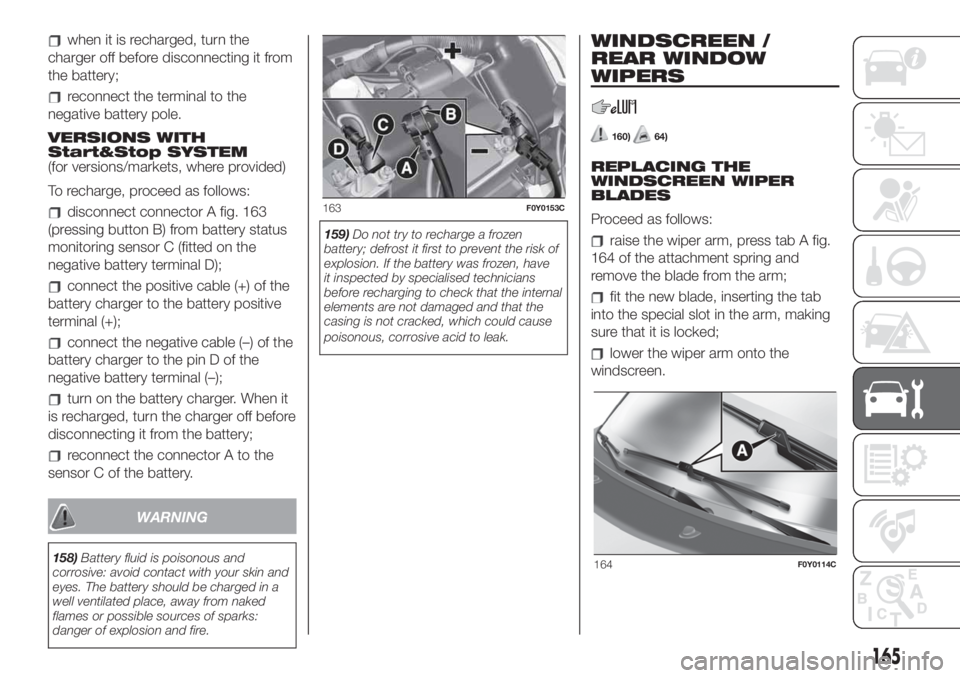
when it is recharged, turn the
charger off before disconnecting it from
the battery;
reconnect the terminal to the
negative battery pole.
VERSIONS WITH
Start&Stop SYSTEM
(for versions/markets, where provided)
To recharge, proceed as follows:
disconnect connector A fig. 163
(pressing button B) from battery status
monitoring sensor C (fitted on the
negative battery terminal D);
connect the positive cable (+) of the
battery charger to the battery positive
terminal (+);
connect the negative cable (–) of the
battery charger to the pin D of the
negative battery terminal (–);
turn on the battery charger. When it
is recharged, turn the charger off before
disconnecting it from the battery;
reconnect the connector A to the
sensor C of the battery.
WARNING
158)Battery fluid is poisonous and
corrosive: avoid contact with your skin and
eyes. The battery should be charged in a
well ventilated place, away from naked
flames or possible sources of sparks:
danger of explosion and fire.159)Do not try to recharge a frozen
battery; defrost it first to prevent the risk of
explosion. If the battery was frozen, have
it inspected by specialised technicians
before recharging to check that the internal
elements are not damaged and that the
casing is not cracked, which could cause
poisonous, corrosive acid to leak.
WINDSCREEN /
REAR WINDOW
WIPERS
160)64)
REPLACING THE
WINDSCREEN WIPER
BLADES
Proceed as follows:
raise the wiper arm, press tab A fig.
164 of the attachment spring and
remove the blade from the arm;
fit the new blade, inserting the tab
into the special slot in the arm, making
sure that it is locked;
lower the wiper arm onto the
windscreen.
163F0Y0153C
164F0Y0114C
165
Page 243 of 248
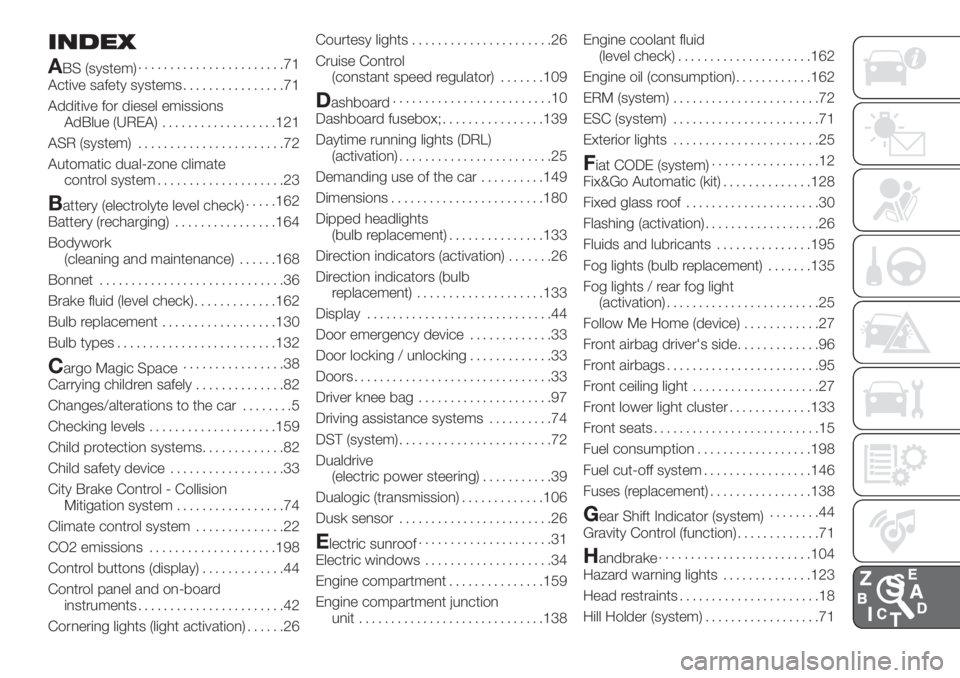
INDEX
A
BS (system).......................71
Active safety systems................71
Additive for diesel emissions
AdBlue (UREA)..................121
ASR (system).......................72
Automatic dual-zone climate
control system....................23
Battery (electrolyte level check).....162
Battery (recharging)................164
Bodywork
(cleaning and maintenance)......168
Bonnet.............................36
Brake fluid (level check).............162
Bulb replacement..................130
Bulb types.........................132
Cargo Magic Space................38
Carrying children safely..............82
Changes/alterations to the car........5
Checking levels....................159
Child protection systems.............82
Child safety device..................33
City Brake Control - Collision
Mitigation system.................74
Climate control system..............22
CO2 emissions....................198
Control buttons (display).............44
Control panel and on-board
instruments.......................42
Cornering lights (light activation)......26Courtesy lights......................26
Cruise Control
(constant speed regulator).......109
Dashboard.........................10
Dashboard fusebox;................139
Daytime running lights (DRL)
(activation)........................25
Demanding use of the car..........149
Dimensions........................180
Dipped headlights
(bulb replacement)...............133
Direction indicators (activation).......26
Direction indicators (bulb
replacement)....................133
Display.............................44
Door emergency device.............33
Door locking / unlocking.............33
Doors...............................33
Driver knee bag.....................97
Driving assistance systems..........74
DST (system)........................72
Dualdrive
(electric power steering)...........39
Dualogic (transmission).............106
Dusk sensor........................26
Electric sunroof.....................31
Electric windows....................34
Engine compartment...............159
Engine compartment junction
unit.............................138Engine coolant fluid
(level check).....................162
Engine oil (consumption)............162
ERM (system).......................72
ESC (system).......................71
Exterior lights.......................25
Fiat CODE (system).................12
Fix&Go Automatic (kit)..............128
Fixed glass roof.....................30
Flashing (activation)..................26
Fluids and lubricants...............195
Fog lights (bulb replacement).......135
Fog lights / rear fog light
(activation)........................25
Follow Me Home (device)............27
Front airbag driver's side.............96
Front airbags........................95
Front ceiling light....................27
Front lower light cluster.............133
Front seats..........................15
Fuel consumption..................198
Fuel cut-off system.................146
Fuses (replacement)................138
Gear Shift Indicator (system)........44
Gravity Control (function).............71
Handbrake........................104
Hazard warning lights..............123
Head restraints......................18
Hill Holder (system)..................71